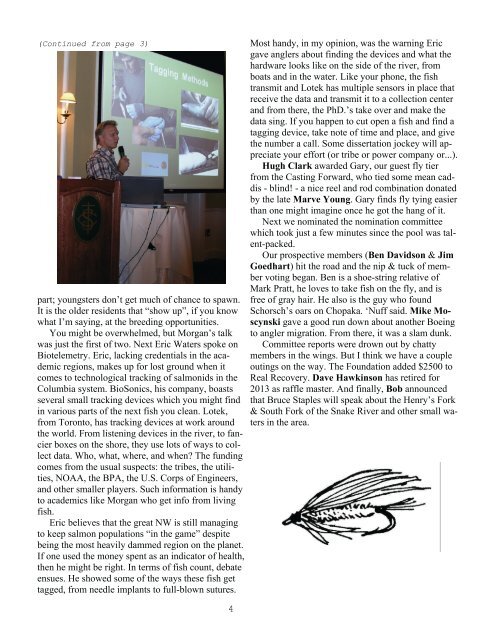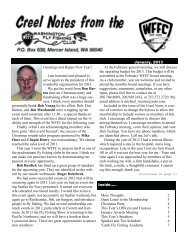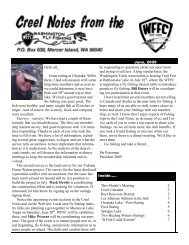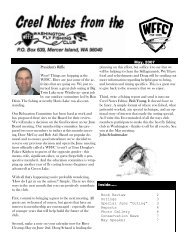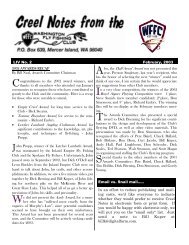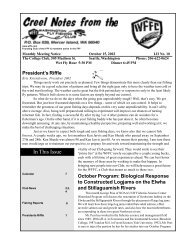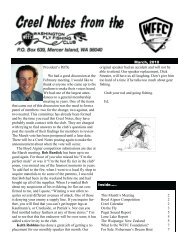Creel Notes - Washington Fly Fishing Club
Creel Notes - Washington Fly Fishing Club
Creel Notes - Washington Fly Fishing Club
Create successful ePaper yourself
Turn your PDF publications into a flip-book with our unique Google optimized e-Paper software.
(Continued from page 3)<br />
part; youngsters don’t get much of chance to spawn.<br />
It is the older residents that “show up”, if you know<br />
what I’m saying, at the breeding opportunities.<br />
You might be overwhelmed, but Morgan’s talk<br />
was just the first of two. Next Eric Waters spoke on<br />
Biotelemetry. Eric, lacking credentials in the academic<br />
regions, makes up for lost ground when it<br />
comes to technological tracking of salmonids in the<br />
Columbia system. BioSonics, his company, boasts<br />
several small tracking devices which you might find<br />
in various parts of the next fish you clean. Lotek,<br />
from Toronto, has tracking devices at work around<br />
the world. From listening devices in the river, to fancier<br />
boxes on the shore, they use lots of ways to collect<br />
data. Who, what, where, and when? The funding<br />
comes from the usual suspects: the tribes, the utilities,<br />
NOAA, the BPA, the U.S. Corps of Engineers,<br />
and other smaller players. Such information is handy<br />
to academics like Morgan who get info from living<br />
fish.<br />
Eric believes that the great NW is still managing<br />
to keep salmon populations “in the game” despite<br />
being the most heavily dammed region on the planet.<br />
If one used the money spent as an indicator of health,<br />
then he might be right. In terms of fish count, debate<br />
ensues. He showed some of the ways these fish get<br />
tagged, from needle implants to full-blown sutures.<br />
4<br />
Most handy, in my opinion, was the warning Eric<br />
gave anglers about finding the devices and what the<br />
hardware looks like on the side of the river, from<br />
boats and in the water. Like your phone, the fish<br />
transmit and Lotek has multiple sensors in place that<br />
receive the data and transmit it to a collection center<br />
and from there, the PhD.’s take over and make the<br />
data sing. If you happen to cut open a fish and find a<br />
tagging device, take note of time and place, and give<br />
the number a call. Some dissertation jockey will appreciate<br />
your effort (or tribe or power company or...).<br />
Hugh Clark awarded Gary, our guest fly tier<br />
from the Casting Forward, who tied some mean caddis<br />
- blind! - a nice reel and rod combination donated<br />
by the late Marve Young. Gary finds fly tying easier<br />
than one might imagine once he got the hang of it.<br />
Next we nominated the nomination committee<br />
which took just a few minutes since the pool was talent-packed.<br />
Our prospective members (Ben Davidson & Jim<br />
Goedhart) hit the road and the nip & tuck of member<br />
voting began. Ben is a shoe-string relative of<br />
Mark Pratt, he loves to take fish on the fly, and is<br />
free of gray hair. He also is the guy who found<br />
Schorsch’s oars on Chopaka. ‘Nuff said. Mike Moscynski<br />
gave a good run down about another Boeing<br />
to angler migration. From there, it was a slam dunk.<br />
Committee reports were drown out by chatty<br />
members in the wings. But I think we have a couple<br />
outings on the way. The Foundation added $2500 to<br />
Real Recovery. Dave Hawkinson has retired for<br />
2013 as raffle master. And finally, Bob announced<br />
that Bruce Staples will speak about the Henry’s Fork<br />
& South Fork of the Snake River and other small waters<br />
in the area.


